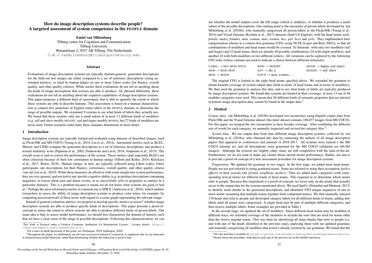How Do Image Description Systems Describe People? A Targeted Assessment of System Competence in the PEOPLE-domain
Evaluations of image description systems are typically domain-general: generated descriptions for the held-out test images are either compared to a set of reference descriptions (using automated metrics), or rated by human judges on one or more Likert scales (for fluency, overall quality, and other quality criteria). While useful, these evaluations do not tell us anything about the kinds of image descriptions that systems are able to produce. Or, phrased differently, these evaluations do not tell us anything about the cognitive capabilities of image description systems. This paper proposes a different kind of assessment, that is able to quantify the extent to which these systems are able to describe humans. This assessment is based on a manual characterisation (a context-free grammar) of English entity labels in the PEOPLE domain, to determine the range of possible outputs. We examined 9 systems to see what kinds of labels they actually use. We found that these systems only use a small subset of at most 13 different kinds of modifiers (e.g. tall and short modify HEIGHT, sad and happy modify MOOD), but 27 kinds of modifiers are never used. Future research could study these semantic dimensions in more detail.
PDF Abstract
 MS COCO
MS COCO
 Visual Genome
Visual Genome
 Flickr30k
Flickr30k